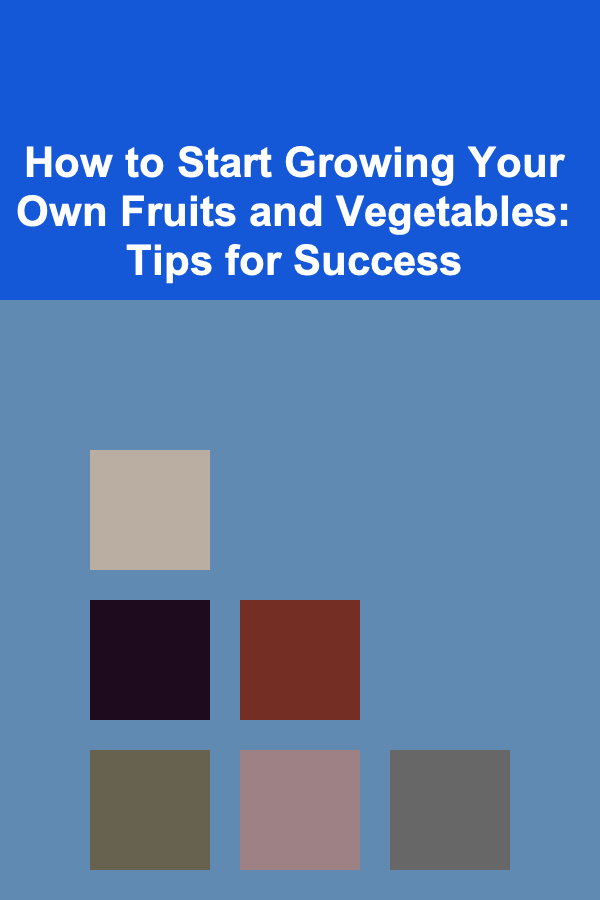
How to Start Growing Your Own Fruits and Vegetables: Tips for Success
ebook include PDF & Audio bundle (Micro Guide)
$12.99$7.99
Limited Time Offer! Order within the next:

Growing your own fruits and vegetables is an incredibly rewarding hobby that not only provides fresh produce but also promotes sustainability and self-sufficiency. Whether you're interested in cultivating a small garden on your balcony or transforming a larger piece of land into a thriving garden, the journey of growing your own food is one that requires patience, knowledge, and a bit of hard work.
This actionable guide will walk you through everything you need to know to get started, from selecting the right plants to creating a healthy growing environment. Whether you're a complete beginner or have some gardening experience, these tips will help you achieve success in growing your own fruits and vegetables.
Understanding Your Space and Environment
Before you dive into planting, it's crucial to understand the environment in which you'll be growing your fruits and vegetables. Different plants have unique requirements, so assessing your space is the first step toward success.
Assess Sunlight and Shade
- Full Sun: Most fruiting vegetables, like tomatoes, peppers, and squash, need full sunlight (at least 6-8 hours per day) to thrive. You should identify areas in your garden that get direct sunlight for most of the day.
- Partial Sun/Partial Shade: Some vegetables, such as leafy greens (spinach, lettuce), do well with 3-5 hours of sunlight each day. These plants can tolerate a bit of shade and are perfect for spots with limited sunlight.
- Full Shade: If your garden is shaded for most of the day, your options are more limited. However, certain plants like mushrooms, herbs (mint, parsley), and some types of lettuce may still grow.
Soil Type and Quality
- Soil Testing: Before planting, it's important to test your soil to understand its pH, nutrient levels, and texture. You can purchase DIY soil test kits or send a sample to a local agricultural extension office for analysis.
- Amending Soil: Depending on your test results, you may need to amend your soil. Adding organic matter like compost, manure, or mulch can improve soil structure, increase nutrient levels, and enhance water retention.
Climate and Growing Zone
- Know Your USDA Hardiness Zone: Your climate zone will determine which fruits and vegetables can thrive in your area. Different regions have different growing seasons, and understanding the hardiness zone is essential to selecting plants that are appropriate for your location.
- Frost Dates: Be mindful of the average last frost date in spring and the first frost date in fall for your area. These dates mark the start and end of the growing season and will help you plan when to plant and harvest.
Choosing the Right Fruits and Vegetables
Choosing the right plants is critical to ensuring a successful harvest. It's best to start small and focus on easy-to-grow vegetables that are well-suited to your climate and soil type.
Best Vegetables for Beginners
- Tomatoes: These versatile plants are perfect for small spaces and grow well in containers or raised beds.
- Lettuce: Quick-growing and ideal for cooler temperatures, lettuce is a great choice for new gardeners.
- Carrots: They are low-maintenance and grow well in deep, loose soil.
- Zucchini and Squash: These plants produce abundant fruits, require minimal care, and can grow well in full sun.
- Beans: Beans are not only easy to grow, but they also enrich the soil with nitrogen, which benefits other plants in the garden.
Best Fruits for Beginners
- Strawberries: Strawberries can be grown in containers, hanging baskets, or raised beds. They require full sun and well-draining soil.
- Raspberries: These are hardy perennial plants that grow well in a variety of climates, producing fruit for multiple years.
- Apples (Dwarf Varieties): If you have space for a tree, dwarf apple trees are a manageable choice for small gardens.
- Blueberries: Blueberries thrive in acidic soils, so consider planting them in containers with acidic soil mixes for best results.
Preparing the Soil
Soil preparation is one of the most important steps in gardening. Healthy soil ensures healthy plants. Here's how to get it right:
Improve Soil Structure
- Add Organic Matter: Enrich your soil by adding organic matter such as compost, leaf mold, or manure. This will improve soil aeration, drainage, and fertility.
- Compost: Creating your own compost is a fantastic way to recycle kitchen scraps and yard waste while providing your plants with the nutrients they need.
- Mulching: Mulch helps retain moisture, prevent weeds, and improve soil quality. It's especially useful in the hot summer months.
Tilling vs. No-Till Gardening
- Tilling: Tilling involves turning the soil over to break up compacted layers. It's useful for starting a new garden but should be done carefully to avoid disrupting soil life.
- No-Till Gardening: No-till gardening focuses on building healthy soil by layering compost and mulch on top rather than tilling. It preserves soil structure and promotes biodiversity.
Planting Your Fruits and Vegetables
Timing and technique matter when it comes to planting. Here's how to ensure your plants are set up for success:
Starting from Seeds vs. Transplants
- Seeds: Starting from seeds is cost-effective but requires more patience. You can start seeds indoors in early spring and transplant them outside once the danger of frost has passed.
- Transplants: For beginners, buying transplants (young plants) from a nursery is a quicker way to get started. This approach bypasses the germination stage and lets you focus on growing healthy plants.
Planting Depth and Spacing
- Follow the Instructions: Different plants require different depths for planting. Always follow seed packet instructions or plant tag guidelines to avoid planting too deep or shallow.
- Spacing: Proper spacing is crucial for healthy plant growth. Overcrowded plants compete for sunlight, water, and nutrients, leading to poor growth. Ensure each plant has enough room to grow to its full size.
Watering and Maintenance
Watering is critical to plant health, but it's easy to overdo it or not provide enough. Here are some guidelines:
Watering Tips
- Consistency is Key: Plants prefer consistent moisture. Water deeply and regularly, especially during dry spells.
- Morning Watering: Water your garden in the morning to give plants a chance to absorb moisture before the heat of the day.
- Avoid Overwatering: Too much water can cause root rot. Ensure that your soil drains well and that plants aren't sitting in soggy conditions.
Fertilizing
- Organic Fertilizers: Choose organic fertilizers like compost or fish emulsion for a natural nutrient boost. These slow-release fertilizers are gentle on plants and improve soil health.
- Liquid Fertilizers: If your plants need a quick boost, consider using liquid fertilizers. They're absorbed faster but should be used sparingly to avoid nutrient imbalances.
Pruning and Harvesting
- Pruning: Regularly prune dead or damaged leaves and stems to encourage healthier growth. Certain plants, like tomatoes and peppers, benefit from pruning to improve airflow and reduce disease risk.
- Harvesting: Harvest your fruits and vegetables at their peak ripeness for the best flavor and nutritional value. Pick them in the morning when temperatures are cooler, as this helps preserve their freshness.
Pest and Disease Management
Pests and diseases are common challenges in gardening. Preventing and managing them is an ongoing task, but with the right approach, you can minimize damage to your crops.
Prevention
- Healthy Plants: Healthy plants are less susceptible to pests and diseases. Maintain good soil, watering practices, and regular maintenance to keep your garden strong.
- Companion Planting: Some plants help repel pests. For example, planting basil near tomatoes can help deter aphids.
- Physical Barriers: Use row covers or mesh netting to protect your plants from insects and animals.
Organic Pest Control
- Neem Oil: A natural pesticide, neem oil is effective against many common garden pests without harming beneficial insects.
- Beneficial Insects: Attracting ladybugs and predatory beetles can help control aphids and other pest populations.
- DIY Remedies: Garlic, chili pepper, and soap sprays can be made at home to deter pests.
Seasonal Care and Crop Rotation
To keep your garden productive year after year, you must adapt to changing seasons and practice crop rotation.
Crop Rotation
- Rotating Plants: Avoid planting the same type of vegetable in the same spot year after year. This helps prevent soil depletion and reduces pest and disease buildup.
- Plan for Each Season: Plant cool-season crops (like peas and lettuce) in early spring or fall, while warm-season crops (like tomatoes and peppers) are better for summer.
Conclusion
Starting your own fruit and vegetable garden is a fulfilling experience that offers numerous rewards. It provides fresh, organic produce, reduces your carbon footprint, and fosters a deeper connection with nature. By understanding your space, preparing your soil, choosing the right plants, and maintaining your garden carefully, you'll be on your way to a successful harvest.
With patience and attention, your garden can thrive season after season, bringing bountiful rewards. Whether you're growing on a small balcony or a large backyard, remember that gardening is an ongoing learning experience. Embrace the process, and you'll soon enjoy the satisfaction of eating food you've grown yourself. Happy gardening!
Reading More From Our Other Websites
- [Home Budget Decorating 101] How to Layer Lighting in Your Home for Style and Savings
- [Personal Care Tips 101] How to Incorporate the Importance of Hydration into Your Daily Personal Care Routine
- [Home Budget Decorating 101] How to Decorate a Bedroom for Relaxation on a Budget
- [Home Party Planning 101] How to Plan a Last-Minute Party Without Losing Your Cool
- [Home Cleaning 101] How to Make Your Bathroom Mirrors Fog-Free
- [Organization Tip 101] How to Create a Home Inventory for Pet Supplies
- [Beachcombing Tip 101] Eco-Friendly Souvenirs: Crafting Home Décor with Sand Dollar Shells
- [Home Rental Property 101] How to Find Rentals with a New Washer and Dryer: Tips for Stress-Free Laundry
- [Personal Care Tips 101] How to Use Sunscreen for Anti-Aging Benefits
- [Simple Life Tip 101] Best Minimalist Travel Packing Lists for One‑Week Adventures

How to Conduct Market Research for Your Small Business
Read More
How to Migrate Existing Systems to Blockchain Architecture
Read More
Why You Should Keep an Ongoing Donation Box
Read More
How to Manage Portion Sizes for Weight Loss
Read More
How to Develop a Private Blockchain
Read More
How to Draft Your Own Corset Pattern
Read MoreOther Products

How to Conduct Market Research for Your Small Business
Read More
How to Migrate Existing Systems to Blockchain Architecture
Read More
Why You Should Keep an Ongoing Donation Box
Read More
How to Manage Portion Sizes for Weight Loss
Read More
How to Develop a Private Blockchain
Read More